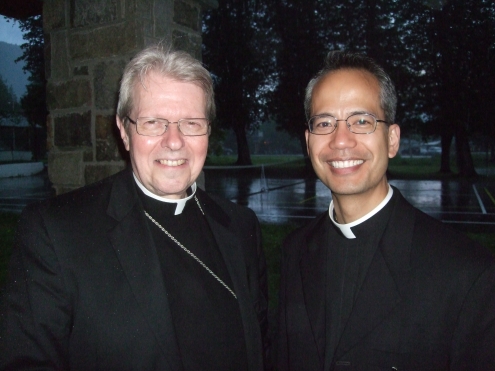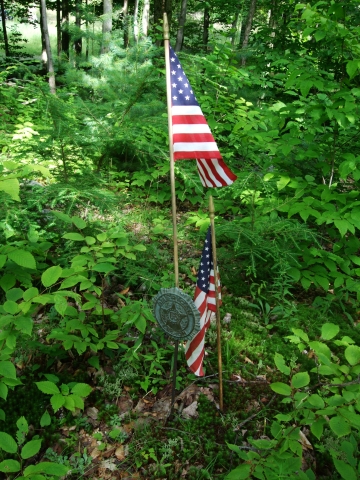
The Roman Catholic Bishop of the Diocese of Albany, Edward B. Scharfenberger, D.D. (left), stands with Fr. Rendell Torres, Pastor of the Chapel of the Assumption (right) in a previous visit to Huletts Landing in 2014.
‘A Return to Mass’
Article taken from the Evangelist (May 17, 2021)
Warmest greetings and every prayer as we approach the end of our journey through this great season of Easter. May you, your families and friends, and indeed all those of good faith, experience the Easter gifts from our Lord of peace, joy and life. For many, if not all of us, Lent, Holy Week and Easter this year have a special and perhaps new meaning. This is especially true as we recall, only too well, the situation we faced last year, with the general lock-down and the suspension of public liturgies in our churches and parish communities.
Indeed, to call the last months that we have lived through “stressful” or “tough” would seem to be a major understatement! Everyone has experienced some form of trial or cross, not least because it has been so unexpected and so prolonged. I feel that for many of us, one of the heaviest burdens has been the unknown: living in uncertain times and sailing through uncharted territory for so long. Despite our fears or worries, we have often had to be strong and resilient for others, not least our family and, indeed, our parish family, even if we have experienced great loss. Hopefully too, we have drawn strength and direction from our relationship with God and from our parish/church family. So, our Lord’s resurrection and the coming of the Holy Spirit at Pentecost certainly takes on a new and perhaps even more profound meaning this year for all of us!
Perhaps too, we can reflect again and discern whether now is the time to return to being at Mass “in person.” Discernment is such a difficult and tricky thing! Yet, it is an integral and essential part of being a disciple. As St. Ignatius of Loyola notes in his Spiritual Exercises, choosing between a good thing and a bad thing is often relatively clear and easy. However, choosing between two goods is so much harder. This is what we might need to face at the moment. On the one hand, we must be safe and healthy and we must keep others safe and healthy too. On the other hand, there is the supreme good of the Mass, the sacraments and prayer. For example, having Mass online is great, but we know that it cannot be a substitute for being there in person and most especially for receiving our Lord in Holy Communion, for He is “real food and real drink” (John 6: 55). Furthermore, our faith is indeed an incarnational faith: one of presence and communion in many ways, especially one of a physical presence. We often speak of the obligation to go to Mass. Yes, there is certainly an obligation, of course, but there is so much more too. Now is a great time to take a fresh look at this matter and see what is best to do, given our own circumstances.
With all this in mind, given the recent changes in regulations and after considerable consultation; from the Solemnity of the Most Holy Body and Blood of Christ (Sunday, 6th June 2021), I will remove the general dispensation from the obligation to go to Mass on Sundays and Holy Days given back in March 2020. However, there would still be a particular dispensation from this obligation for those in certain circumstances; such as those who are sick or who are at risk, or who care for those who are sick or at risk, or those who experience a significant anxiety or fear of getting sick from being in a public setting.
It is hard to gauge how many people might return to being present at Mass in person because of this return to the norm. Evidence, admittedly anecdotal, indicates that many people would continue to make a prudential judgment about what to do. It may or may not be necessary for parish leaders to make considered decisions about what best to do, as they have done throughout the pandemic. Whatever the case, given the ongoing limits on the capacity of our churches (especially due to social distancing), it may not be possible for people to attend Mass and that good intention would also be included in that particular dispensation. Again, as you have done throughout this pandemic, a prudent and considered decision should be made by each person.
In charity and concern for others, at the Mass and other liturgies, we should continue to follow the various directives regarding health protocols such as social distancing, face masks and sanitizing. As the next few months unfold, the various liturgical guidelines will continue to be examined and more of the special arrangements put in place will be lifted, as and when it is safe and possible to do so. I would also like to thank deeply and personally parish leaders, staff and volunteers and Diocesan staff for all the incredible hard work that they have done and the amazing initiatives that they have launched, in keeping us safe as we celebrate the Mass and the sacraments in these difficult times.
The promise of new life that Jesus brings at Easter and, of course, the powerful and practical gifts of the Holy Spirit, are also then about our present, as well as our future. As Jesus says: “I have come that they might have life and have it abundantly” (John 10: 10). Our experiences over these last months may well have been hard and difficult, but, please God, we have also experienced light, goodness and hope. The terrible effects of the health crisis have also made us aware, and even made us rethink, what is really important in our lives; what really matters. Life is a gift and indeed a gift from God, but it is as fragile as it is precious. It cannot be taken for granted.
So, this year, it strikes me that the message of Easter about resurrection and new life is especially about the here and now. So, perhaps now is the time to focus on that Easter message of a resurrection right now. Yes, of course there are still obstacles and difficulties; but there are also all those Easter gifts of hope, strength and determination. Above all, let us experience that Easter gift of “peace.” Remember that the first words of our Lord to the apostles gathered as frightened people in the Upper Room were “peace be with you” (John 20: 19).
Sincerely yours in Christ,
Edward B. Scharfenberger
Bishop of Albany







